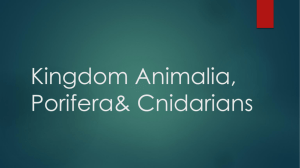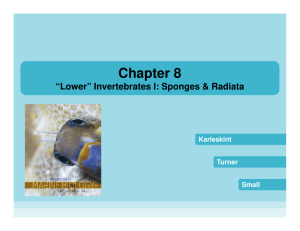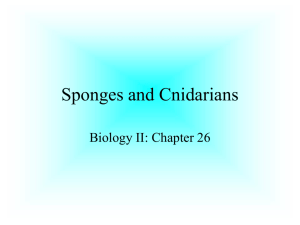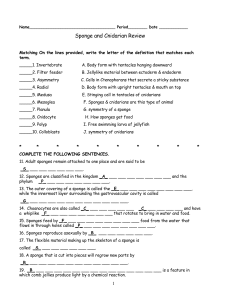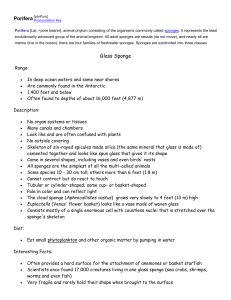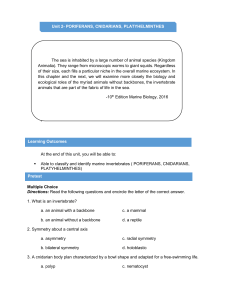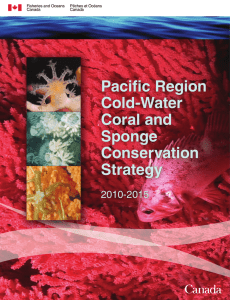Sponges Chapter 9 Section3
advertisement
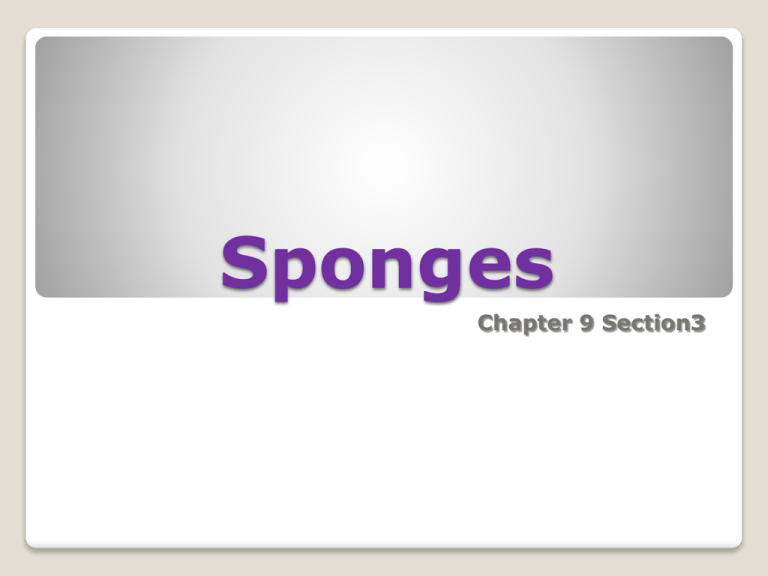
Sponges Chapter 9 Section3 Live all over the world (oceans, freshwater rivers and lakes) Sponges Invertebrate animals No body symmetry Never have tissues or organs Looks like a hollow bag ◦Large opening at one end and tiny pores covering the surface Spikes support and protect sponges body Sponge: Body Structure Eats tiny single-celled organisms Collar cells that line central cavity, trap the tiny organisms Jelly-like cells inside sponge digest, or break down, the food Sponges get oxygen from water https://www.youtube.com/watch?v=RmPT M965-1c Sponge: Obtaining Food and Oxygen Asexually ◦ Budding: small new structures grow from the sides on an adult sponge ◦ Buds eventually break free and begin new life Sexually ◦ Sponges produce both sperm cells and egg cells (do not have separate sexes) ◦ Sperm cells released in water, enter another sponge, fertilize its eggs, larva develops ◦ Larva: immature form of an animal that looks very different from the adult Sponges: Reproduction Cnidarians Chapter 9 Section3 Jellyfish, corals, and sea anemones Invertebrates that have stinging cells to capture food and protect themselves Take food into central body cavity Cnidarians Two different body plans (vase and bowl) Radial symmetry Central hollow cavity Tentacles containing stinging cells Cnidarians: Body Structure Vase-shaped body plan is a POLYP Sea anemone Mouth opens at top Tentacles spread out from around mouth Most are attached to underwater surface Body Structure: Polyp Bowl-shaped body plan is a MEDUSA Jellyfish Adapted for a swimming life Mouths open downward and tentacles trail down Body Structure: Medusa Use stinging cells to catch animals they eat (prey) Contains threadlike structure with spines Uses tentacles to pull prey to mouth Takes food into central body cavity Expels undigested food through mouth Obtaining Food Unlike adult sponges, many cnidarians move to escape danger and to obtain food Jellyfish? Sea Anemones? Movement Asexual Reproduction ◦ Hydras, corals, and sea anemones Sexual Reproduction ◦ Jellyfish Reproduction Colony ◦ a group of many individual animals Stony corals and Portuguese man-ofwar Life in a Colony a coral reef is built by cnidarians coral reefs are home to more species of fishes and invertebrates than any other environment on Earth Coral polyps produce hard, stony skeletons around their soft bodies Stony Coral Contains as many as 1,000 individuals that function together as one unit Top: gas filled chamber, allows colony to float Bottom: polyps with different functions drift below ◦ Some catch prey and help with digestion and reproduction Portuguese Man-of-War


